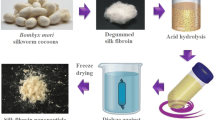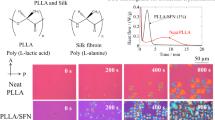Abstract
A series of poly(vinyl alcohol) (PVA)/regenerated silk fibroin (RSF)/nano-silicon dioxide (nano-SiO2) blend films were prepared by solution casting method, in which nano-SiO2 was obtained via sol–gel process. The structure, properties, and morphology of the films related to the compatibility were investigated by X-ray diffraction (XRD), Fourier transform infrared spectroscopy (FTIR), scanning electron microscopy (SEM), transmission electron microscopy (TEM), differential scanning calorimetry (DSC), and thermogravimetric analysis (TGA). XRD peaks of PVA/RSF/nano-SiO2 (1.0 wt %) blends decreased in intensity indicated that formation of PVA and RSF crystal lattices was hindered by nano-SiO2 particles. FTIR spectroscopy analysis of PVA/RSF/nano-SiO2 films confirmed that both Si–O–C linkage and hydrogen bonding were formed among PVA, RSF, and nano-SiO2. SEM showed that there was no obvious phase separation in PVA/RSF/nano-SiO2 (1.0 wt %) film although small uniform blur particles can still be found. In addition, TEM showed nano-particles were well dispersed through the PVA/RSF polymer matrix. Besides, the observed shift in glass transition temperatures (T g) and improvement in thermal properties of composite films suggested the enhanced compatibility due to interfacial bonding and intermolecular interactions. Therefore, these results indicated that the compatibility of PVA/RSF was improved effectively by the addition of nano-SiO2.








Similar content being viewed by others
References
Kim UJ, Park J, Li C, Jin HJ, Valluzzi R, Kaplan DL (2004) Structure and properties of silk hydrogels. Biomacromolecules 5:786–792
Altman GH, Horan RL, Lu HH, Moreau J, Martin I, Richmond JC, Kaplan DL (2002) Silk matrix for tissue engineered anterior cruciate ligaments. Biomaterials 23:4131–4141
Zhou W, He J, Du S, Cui S, Gao W (2011) Electrospun silk fibroin/cellulose acetate blend nanofibres: structure and properties. Iran Polym J 20:389–397
Yeo JH, Lee KG, Lee YW, Kim SY (2003) Simple preparation and characteristics of silk fibroin microsphere. Eur Polym J 39:1195–1199
Wang XQ, Yucel T, Lu Q, Hu X, Kaplan DL (2010) Silk nanospheres and microspheres from silk/pva blend films for drug delivery. Biomaterials 31:1025–1035
Nair LS, Laurencin CT (2007) Biodegradable polymers as biomaterials. Prog Polym Sci 32:762–798
Hardy JG, Scheibel TR (2010) Composite materials based on silk proteins. Prog Polym Sci 35:1093–1115
Jia YT, Gong J, Gu XH, Kim HY, Dong J, Shen XY (2007) Fabrication and characterization of poly(vinyl alcohol)/chitosan blend nanofibers produced by electrospinning method. Carbohydr Polym 67:403–409
Wang H, Wang W, Jiang S, Jiang S, Zhai L, Jiang Q (2011) Poly(vinyl alcohol)/oxidized starch fibres via electrospinning technique: fabrication and characterization. Iran Polym J 20:551–558
Lakouraj MM, Tajbakhsh M, Mokhtary M (2005) Synthesis and swelling characterization of cross-linked PVP/PVA hydrogels. Iran Polym J 14:1022–1030
Dai L, Ying L (2002) Infrared spectroscopic investigation of hydrogen bonding in EVOH containing PVA fibers. Macromol Mater Eng 287:509–514
Tsukada M, Freddi G, Crighton JS (1994) Structure and compatibility of poly(vinyl alcohol)-silk fibroin (PVA/SF) blend films. J Polym Sci, Part B: Polym Phys 32:243–248
Um IC, Kweon HY, Park YH, Hudson S (2001) Structural characteristics and properties of the regenerated silk fibroin prepared from formic acid. Int J Biol Macromol 29:91–97
Um IC, Park YH (2007) The effect of casting solvent on the structural characteristics and miscibility of regenerated silk fibroin/poly(vinyl alcohol) blends. Fiber Polym 8:579–585
Dai L, Li J, Yamada E (2002) Effect of glycerin on structure transition of PVA/SF blends. J Appl Polym Sci 86:2342–2347
Zhang Q, Yang H, Fu Q (2004) Kinetics-controlled compatibilization of immiscible polypropylene/polystyrene blends using nano-SiO2 particles. Polymer 45:1913–1922
Tang S, Zou P, Xiong H, Tang H (2008) Effect of nano-SiO2 on the performance of starch/polyvinyl alcohol blend films. Carbohydr Polym 72:521–526
Xiong HG, Tang SW, Tang HL, Zou P (2008) The structure and properties of a starch-based biodegradable film. Carbohydr Polym 71:263–268
Zhuravlev LT (2000) The surface chemistry of amorphous silica zhuravlev model. Colloids Surf A 173:1–138
Lipatov YS, Nesterov AE, Ignatova TD, Nesterov DA (2002) Effect of polymer-filler surface interactions on the phase separation in polymer blends. Polymer 43:875–880
Shao L, Mu C, Huang Y, Ding S, Li X, Bai Y, Huang Y (2011) Enhancement of ink-receiving properties of SiO2/PVA composite films by using rare earth-modified SiO2 particles. Iran Polym J 20:955–967
Nakane K, Yamashita T, Iwakir K, Suzuki F (1999) Properties and structure of poly(vinyl alcohol)/silica composites. J Appl Polym Sci 74:133–138
Xu Y, Li ZH, Fan W, Wu D, Sun Y, Rong L, Dong B (2004) Density fluctuation in silica-PVA hybrid gels determined by small-angle X-ray scattering. Appl Surf Sci 225:116–123
Hou A, Chen H (2010) Preparation and characterization of silk/silica hybrid biomaterials by sol–gel crosslinking process. Mater Sci Eng, B 167:124–128
Buckley AM, Greenblatt M (1994) The sol–gel preparation of silica gels. J Chem Educ 71:599–602
Li M, Minoura N, Dai L, Zhang L (2001) Preparation of porous poly(vinyl alcohol)-silk fibroin (PVA/SF) blend films. Macromol Mater Eng 286:529–534
Li M, Lu S, Wu Z, Tan K, Minoura N, Kuga S (2002) Structure and properties of silk fibroin-poly(vinyl alcohol) gel. Int J Biol Macromol 30:89–94
Lee KH (2004) Silk sericin retards the crystallization of silk fibroin. Macromol Rapid Commun 25:1792–1796
Venyaminov SY, Kalnin NN (1990) Quantitative IR spectrophotometry of peptide compounds in water (H2O) solutions. II. Amide absorption bands of polypeptides and fibrous proteins in α-, β-, and random coil conformations. Biopolymers 30:1259–1271
Shao L, Chung TS (2009) In situ fabrication of cross-linked PEO/silica reverse-selective membranes for hydrogen purification. Int J Hydrogen Energy 34:6492–6504
Stiubianu G, Cazacu M, Nicolescu A, Hamciuc V, Vlad S (2010) Silicone-modified cellulose. Crosslinking of the cellulose acetate with 1, 1, 3, 3-tetramethyldisiloxane by Pt-catalyzed dehydrogenative coupling. J Polym Res 17:837–845
Shao C, Kim HY, Gong J, Ding B, Lee DR, Park SJ (2003) Fiber mats of poly(vinyl alcohol)/silica composite via electrospinning. Mater Lett 57:1579–1584
Hajji P, David L, Gerard JF, Pascault JP, Vigier G (1999) Synthesis, structure, and morphology of polymer-silica hybrid nanocomposites based on hydroxyethyl methacrylate. J Polym Sci, Part B: Polym Phys 37:3172–3187
Tsukada M, Freddi G, Kasai G (1994) Physical properties and phase separation structure of aniheraea pernyi/bombyx silk fibroin blend films. J Polym Sci, Part B: Polym Phys 32:1175–1182
Agarwal N, Hoagland DA, Farris RJ (1997) Effect of moisture absorption on the thermal properties of bombyx mori silk fibroin films. J Appl Polym Sci 63:401–410
Akatsuka M, Takezawa Y, Amagi S (2001) Influences of inorganic fillers on curing reactions of epoxy resins initiated with a boron trifluoride amine complex. Polymer 42:3003–3007
Acknowledgments
This research was financially supported by the Priority Academic Program Development of Jiangsu Higher Education Institutions. We also acknowledge the support from National Engineering Laboratory for Modern Silk. We would like to thank Dr. Wenli Li and Dr. Mingbo Gu for their help on the experiments.
Author information
Authors and Affiliations
Corresponding author
Rights and permissions
About this article
Cite this article
Liu, Y., Huang, M., Cai, D. et al. Effect of nano-SiO2 on the compatibility of PVA/RSF blend. Iran Polym J 21, 523–530 (2012). https://doi.org/10.1007/s13726-012-0057-7
Received:
Accepted:
Published:
Issue Date:
DOI: https://doi.org/10.1007/s13726-012-0057-7




